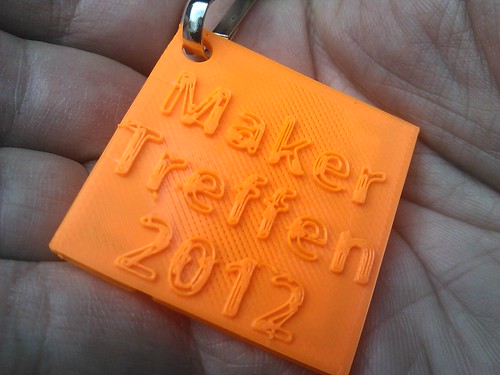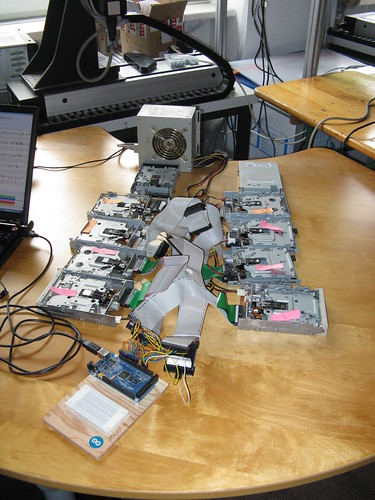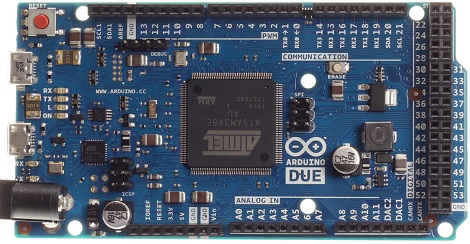Posts with «arduino due» label
Arduino Due VGA Signal Out
Photo credit: [Stimmer] on the Arduino Forum
[Stimmer] on the Arduino Forum hardcoded a way to display 160×240 (320×240 after some posts) VGA signal.
After working out how to do a timer interrupt I’ve had a go at making a VGA framebuffer. It is rather low-res at present(160×240) and fuzzy but I hope to be able to improve that. It has 8-bit colour (RRRGGGBB).
I cannot get Eagle to run right now so will have to describe the schematic in text:
Due pin 2 -> VGA pin 13 (HSync)
Due pin 3 -> VGA pin 14 (VSync)Due pin 25 -> 820R resistor -> VGA pin 3 (blue)
Due pin 26 -> 390R resistor -> VGA pin 3 (blue)Due pin 27 -> 2k2 resistor -> VGA pin 2 (green)
Due pin 28 -> 1k resistor -> VGA pin 2 (green)
Due pin 14 -> 470R resistor -> VGA pin 2 (green)Due pin 15 -> 2k2 resistor -> VGA pin 1 (red)
Due pin 29 -> 1k resistor -> VGA pin 1 (red)
Due pin 11 -> 470R resistor -> VGA pin 1(red)Due pin GND -> VGA pins 5,6,7,8,10
Via [Arduino Forum]
Drive a DC Motor With Arduino DUE

We are proud to show you a tutorial about using an Arduino Motor Shield with the Arduino Due. This example shows the simplest thing you can do: driving a DC motor forward and backwards.
Read on the [tutorial]
Hamburg Maker Meeting 2012 and Arduino Due preview

Hamburg Maker Meeting 2012, which took place last week and involved about 200 visitors and more than 20 exhibitors, has been a fantastic opportunity to meet and share experience regarding several topics, such as 3D printing, hacking, retro gaming and so on. At the Attraktor Makerspace, several projects have been presented and demonstrated by their inventors, among which we highlight a very nice Arduino-based floppy drive organ that has been employed to play the Tetris game theme.

Moreover, among the others events planned for the meeting, a special sneak-preview session allowed all the interested people to get some insights on the new Arduino Due board, released a couple of days ago.
A video of the event can be found here, while here you may find more pictures.
More information can be found on the homepage of the meeting.
Meet the Arduino Due, the 32-bit board that'll let your projects fly (really)
As much as we love the Arduino Uno, it's not the most powerful of hobbyist microcontrollers. Fortunately, the folks in Turin have just put the finishing touches on a 32-bit upgrade with buckets of potential. At the heart of the Arduino Due is an 84MHz Atmel CPU, based on ARM's Cortex M3 Architecture, which is capable of being the brains inside your own flying drone or homemade 3D printer. It should start trickling out onto shelves from today, setting you back $49, but hey, that's a small price to pay to automate your drinking adventures.
Continue reading Meet the Arduino Due, the 32-bit board that'll let your projects fly (really)
Filed under: Misc
Meet the Arduino Due, the 32-bit board that'll let your projects fly (really) originally appeared on Engadget on Mon, 22 Oct 2012 09:22:00 EST. Please see our terms for use of feeds.
Permalink | Email this | CommentsThe Arduino Due is finally here

After a years-long wait, an ARM powered Arduino is finally due. The Arduino Due will finally be released this coming Monday.
On board the Arduino Due is an Atmel-sourced ARM Cortex M3 microcontroller running at 84 MHz. The Due has an impressive list of features including a USB 2.0 host, compatibility with the Android ADK (lest you still need an IOIO), 12 analog inputs with 12-bit resolution, 2 analog outputs running at 12 bits, a CAN interface, and more input pins than you can shake a stick at.
For a full list of features, you can grab this PDF we picked up when we saw the Due at Maker Faire NYC
This hardware update to the Arduino platform makes a lot of very cool builds very possible for even the beginner hardware hacker. Of course the Due will be used for controlling drones and UAVs, laser cutters and 3D printers, and playing WAV files from the analog outputs. The much improved hardware opens up a lot of other possible builds including making your own guitar pedals – DSP is a wonderful thing – and reading the telemetry from your car in real-time via the CAN bus.
Although it’s not available right now, you will be able to buy an Arduino Due for $49 USD this coming Monday at your favorite electronics retailers.
Filed under: arduino hacks, ARM

Finally, an ARM-powered Arduino

Far removed from the legions of 3D printers featured at this year’s Maker Faire in New York was a much smaller, but far more impressive announcement: The ARM-powered Arduino DUE is going to be released later this month.
Instead of the 8-bit AVR microcontrollers usually found in Arduinos, the DUE is powered by an ATSAM3X8E microcontroller, itself based on the ARM Cortex-M3 platform. There are a few very neat features in the DUE, namely a USB On The Go port to allow makers and tinkerers to connect keyboards, mice, smartphones (hey, someone should port IOIO firmware to this thing), and maybe even standard desktop inkjet or laser printers.
The board looks strikingly similar to the already common Arduino Mega. That’s no mistake; the DUE is compatible with existing shields, so connecting a RAMPS board for your 3D printer should be a snap.
Here’s a PDF the Arduino and Atmel guys were handing out at their booth. A few DUE boards have already made it into the hands of important people in the Arduino community, including 3D printer guru [Josef Prusa]. Sadly, the folks at Arduino didn’t think media personalities needed a DUE before its release, so you’ll have to wait until we get our hands on one later this month for a review.
Filed under: arduino hacks, Microcontrollers





